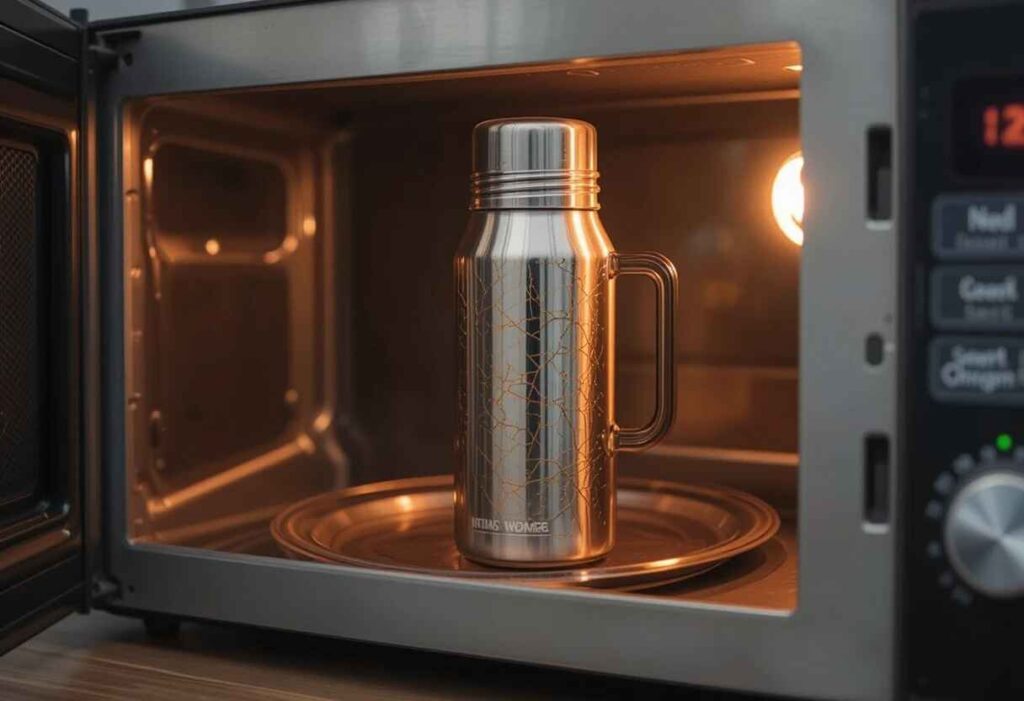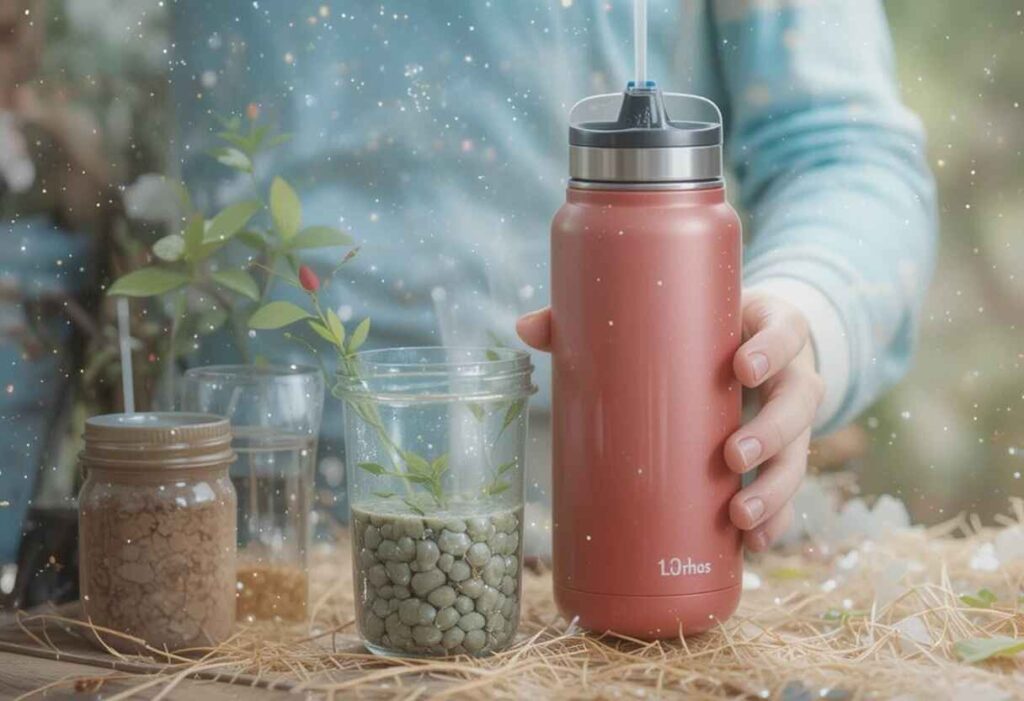Microwaves have become an essential part of daily life, offering quick and easy ways to heat food and drinks. Many people rely on a thermos to keep beverages hot for hours, especially during work, travel, or outdoor activities. While it may seem convenient to warm a drink or soup right in the thermos, this is actually not safe.
Thermos containers have special designs and materials that do not work well with microwave heating. In this guide, you’ll find a clear explanation of why it’s unsafe to microwave a thermos, the risks involved, safer alternatives for heating, and tips to maintain your thermos for long-lasting use. By understanding how a thermos works and how microwaves interact with its materials, you can make better choices and keep yourself and your appliances safe.
Why Microwaving a Thermos Is Not Recommended?
Let’s begin by understanding why experts advise against it.
A thermos is designed with vacuum insulation to maintain the temperature of its contents for hours. This insulation relies on an airless gap between walls, minimizing heat transfer. While this is excellent for keeping drinks hot or cold, it is dangerous in a microwave.
- The vacuum barrier traps heat and steam without allowing safe venting.
- Pressure can build up quickly, risking an explosion or cracking.
- Microwaves heat unevenly inside a sealed thermos, leading to hot spots.
- Metal parts can spark, damage the microwave, or start a fire.
Overall, the risk of damage to both your thermos and your microwave outweighs any small convenience.
How do Thermos Materials React in the Microwave?

Different thermos materials respond differently when heated in a microwave. Here’s what you need to know:
Stainless Steel Thermos:
Stainless steel is a highly reflective metal. Microwaves bounce off its surface, which can cause:
- Electrical sparks (arcing)
- Fires inside the microwave
- Damage to the microwave’s magnetron (the heating element)
- Warping or damage to the thermos itself
Because of these risks, no manufacturer recommends placing stainless steel in a microwave.
Plastic Thermos:
Plastic thermoses may seem safer, but they also pose problems:
- Plastics can warp or melt with high microwave heat.
- Some plastics release harmful chemicals, contaminating food.
- Even “microwave-safe” plastics can degrade over time if used improperly.
If a plastic thermos is not labeled microwave-safe, you should never heat it this way
Glass Thermos with Vacuum Insulation:
Many glass thermoses use vacuum insulation to maintain temperature. Microwaving them is dangerous because:
- The vacuum layer traps steam with no way to escape.
- Pressure can build up until the glass cracks or explodes.
- Heat can be very uneven, causing unpredictable breakage.
How Does Thermos Material Affect Microwave Safety?
| Material Type | Microwave Behavior | Risks |
| Stainless Steel | Reflects microwaves, sparks occur | Fire hazard, microwave damage |
| Plastic | Can melt or warp | Chemical leaching, burns |
| Glass (Vacuum) | Traps steam, uneven heating | Pressure build-up, potential explosion |
How Does Microwave Heating Work?
Microwave ovens use electromagnetic waves to heat food. These waves cause water molecules in food to vibrate rapidly, creating heat. However, metals reflect these waves instead of absorbing them.
When you place a metal thermos in the microwave, it doesn’t heat the contents evenly. Instead, the waves bounce around, creating sparks. Even with plastic or glass, the sealed vacuum insulation doesn’t allow heat to spread evenly, leading to pressure build-up that can be dangerous.
What Are the Risks of Microwaving a Thermos?
Fire Hazard:
Metal in a thermos, especially stainless steel, reflects microwaves rather than absorbing them. This reflection creates electrical sparks that can ignite food, paper, or other materials inside your microwave. Such sparks may damage the microwave’s internal parts, start a fire, and pose a serious safety risk in your kitchen environment.
Explosion Risk:
Thermoses use vacuum insulation to trap heat efficiently. When microwaved, steam and pressure build up inside the sealed container because there’s no venting path. This sudden pressure can cause the thermos to crack or explode violently, sending scalding liquids everywhere and posing a severe burn hazard to anyone nearby when it bursts open.
Chemical Contamination:
Plastic thermoses not specifically labeled microwave-safe can warp, melt, or degrade when exposed to high microwave heat. This breakdown can release harmful chemicals like BPA or other toxins directly into your food or drink. Over repeated use, these chemicals accumulate, leading to health concerns and making your meals less safe to consume.
Thermal Burns:
Microwave ovens often heat unevenly, and inside a sealed thermos, this effect is worse. Pockets of liquid can become dangerously hot while other areas stay cooler. When you open the lid or drink immediately, these hidden hot spots can cause painful burns to your mouth, lips, or hands, creating an unnecessary safety risk.
What Are Some Safer Alternatives for Heating Food and Drinks?
There are several safe and effective ways to heat your food or drinks without placing your thermos in the microwave. One of the best options is transferring the contents into a microwave-safe container, such as a glass or ceramic bowl, or BPA-free plastic labeled for microwave use. Eco-friendly choices like PaperPlus containers are also designed for safe microwaving.
For soups and stews, gently warming them on the stovetop ensures even heating and preserves taste. If you’re dealing with liquids like tea or coffee, an electric kettle or immersion heater can quickly heat water, which you can then pour into your thermos to keep it hot. These alternatives help avoid risks like sparks, pressure buildup, and chemical contamination, offering a safer, smarter way to enjoy your meals warm.
What Are the Best Practices for Using a Thermos?
- Preheat with Hot Water: Before adding any hot drink, fill your thermos with boiling water for a few minutes. This warms the interior, helping your beverage stay hot much longer and maintaining the desired temperature throughout your day without needing repeated reheating.
- Pre-Chill with Cold Water or Ice: For cold drinks, pour in ice water or add a few ice cubes to pre-chill the inside of your thermos. This step keeps beverages cold for extended periods, making it perfect for summer outings, workdays, or travel without losing its cooling power.
- Avoid Harsh Detergents or Abrasives: Clean your thermos using mild soap and a soft sponge or bottle brush. Harsh cleaners or abrasive scrubbers can scratch surfaces or damage seals, reducing its insulating power over time and making it harder to keep drinks at their ideal temperature.
- Dry Completely Before Sealing: After washing, leave your thermos open and allow it to air dry fully before putting the lid back on. Trapped moisture can encourage mold or bad odors, making it unhygienic. Ensuring it’s dry keeps it fresh and safe for repeated use.
- Regular Deep Cleaning: Every so often, deep clean your thermos by filling it with warm water and adding baking soda or vinegar. Let it soak to remove stubborn stains or lingering smells. This gentle but effective method helps maintain a clean interior without damaging any parts.
What Are Some Effective Cleaning Tips for Longevity?
Smooth transition: Keeping your thermos clean ensures safe, long-lasting use and preserves its performance over time.
- Daily Cleaning: Wash your thermos every day with mild soap and warm water. Use a soft bottle brush to reach all interior surfaces and remove residue thoroughly. This routine cleaning prevents buildup of odors or flavors and keeps your drinks tasting fresh and pleasant.
- Deep Cleaning: For a deeper clean, fill your thermos with warm water and add baking soda to help remove odors. For tough stains, include a splash of vinegar. Let it soak for several hours or overnight before rinsing well to maintain a spotless, odor-free interior.
- Avoid Bleach: Never use bleach or other harsh chemicals on your thermos. These substances can damage the internal lining, break down rubber seals, and reduce the insulation’s effectiveness. Using gentle cleaners helps extend the life of your thermos while keeping it safe for daily use.
- Air Drying: After washing, always let your thermos air dry completely with the lid off. This practice prevents moisture buildup that can lead to mold, mildew, or unpleasant smells. Fully drying it before sealing ensures your thermos stays hygienic and ready for your next use.
What Is the Environmental Impact of Using a Thermos?
Using a thermos helps reduce waste by replacing single-use cups and disposable food containers. With proper care, a thermos can last for years, cutting down on the need for constant replacements and lowering your carbon footprint. Some eco-conscious brands also use recyclable or sustainable materials in their designs, making them a smart and responsible choice for daily use.

By using a thermos consistently, you contribute to a cleaner planet and promote long-term environmental responsibility through small, everyday actions. Over time, these habits encourage others to make more conscious decisions as well. Every refill matters when it comes to protecting natural resources.
What Are Expert Recommendations and Manufacturer Guidelines?
Following expert advice and manufacturer instructions is essential for safe and effective use of your thermos. Most reputable brands include clear warnings like “Do not microwave,” “Hand-wash only,” and “Avoid direct heating.” These guidelines exist to protect the vacuum insulation and prevent accidents. Ignoring them can void warranties, shorten the lifespan of your thermos, and even create safety hazards during use. Always take the time to read and follow the user manual that comes with any new thermos to ensure you’re using it correctly and getting the best performance.
FAQS:
Can I put my metal thermos in the microwave?
No, you should never put a metal thermos in the microwave. Metal reflects microwave energy, creating sparks that can damage your appliance or start a fire. Always transfer food or drink into a microwave-safe container before heating to keep everything safe.
How do you warm up a thermos?
To warm up your thermos, fill it with hot water and let it sit for a few minutes before emptying it. Then add your hot drink or food. This simple step keeps contents hot much longer without needing to microwave the thermos itself.
Are thermos food containers microwave safe?
Most thermos food containers are not microwave safe, especially those with stainless steel or vacuum insulation. Microwaving them can cause sparks, pressure build-up, or chemical leaching. Always check manufacturer instructions and use proper microwave-safe containers for reheating food safely and evenly.
Is it safe to put stainless steel in a microwave?
No, it’s not safe to put stainless steel in a microwave. Stainless steel reflects microwave energy, causing dangerous sparks that can damage the microwave’s interior or even start fires. Always avoid placing any metal objects in your microwave to prevent accidents and damage.
What is the best way to reheat food from a thermos?
The best way is to transfer the contents into a microwave-safe container like glass, ceramic, or BPA-free plastic. Heat it in short intervals, stirring for even warmth. Once it’s heated properly, you can pour it back into your thermos to keep it hot.
Conclusion:
Microwaving a thermos is not recommended due to risks of fire, pressure explosions, chemical contamination, and damage to both the thermos and the microwave. Whether made of stainless steel, plastic, or glass with vacuum insulation, a thermos simply isn’t designed to handle microwave energy.
By understanding these risks and choosing safer alternatives like microwave-safe containers, stovetop heating, or electric kettles, you can keep your food warm safely and extend the life of your thermos. Proper cleaning and maintenance add even more value, making it a reliable companion for daily use.Choose safe heating methods and enjoy the benefits of your thermos without worry.
Related post:
- Are Compostable Plates Microwave Safe – Best Practices And Hidden Risks Revealed!
- Can A Countertop Microwave Be Installed In A Cabinet – Expert Guide & Mistakes To Avoid!
- Aluminium Foil In The Microwave – The Complete Guide To Using It Right!
